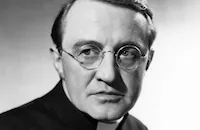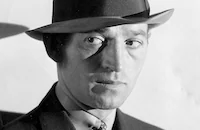Night of the Quarter Moon

Brief Synopsis
Cast & Crew
Hugo Haas
Julie London
John Drew Barrymore
Anna Kashfi
Dean Jones
Agnes Moorehead
Film Details
Technical Specs

Synopsis
In San Francisco, newlywed Ginny O'Sullivan Nelson is cheerfully hanging paintings to decorate her new home when neighborhood teenagers hurl stones through the living room window. Terrified, Ginny telephones her husband Roderic "Chuck" Nelson who rushes home immediately and confronts the belligerent teens still menacing the house. Ginny runs out onto the lawn to intervene in the shouting match and, when one boy flings her to the ground, Chuck attacks him. The fight is broken up by the arrival of the police who take everyone but Ginny into custody. At the police station, the father of one of the disruptive boys enrages Chuck by insisting that Ginny taunted the youths by appearing half-dressed in the windows of her living room. On her way to the station to help Chuck, Ginny is picked up by the police and she and Chuck are grilled in separate police rooms about the event. Despite Ginny's explanations, the police insist that she played a part in starting the brawl and invite the press to the room, many of whom mock her and suggest she return to her home in Mexico. The goading prompts Ginny to recall her meeting Chuck: Several weeks earlier, Chuck and his brother Lexington arrive at a quiet Mexican coastal village for a week of fishing with Capt. Tom O'Sullivan. Lex, who has made the trip regularly, hopes the change of scenery will engage Chuck, who is still recovering from two years in a Korean prisoner-of-war camp. The next day while out walking, Chuck comes upon Tom's daughter Ginny swimming nude in an inlet and, after asking for a moment's privacy to dress, Ginny joins Chuck on shore. When Ginny inquires about Chuck's POW experience, he responds bitterly, then apologizes, realizing Ginny was offering him understanding. A couple of days later, Lex and Chuck receive a telegram from their mother Cornelia, requesting they return to handle a political matter regarding their vast, wealthy company. Enjoying the calm atmosphere and Ginny's company, Chuck asks to remain behind and Lex, pleased to see an emotional improvement in his brother, readily agrees. Over the next several days, Chuck and Ginny become close and one afternoon, while describing how she and Tom came to live in Mexico from Spain, Ginny reveals that her maternal grandfather was a Spaniard who married a Portuguese-Angolian woman. When Chuck fails to respond, Ginny points out that her grandmother was a black African, making her one-quarter black. Instead of expressing concern, Chuck declares that knowing her has provided him the first happiness since his return from the war and announces his intention to remain in Mexico. Soon after, Chuck is dismayed when Tom gives him a note from Ginny informing him that she has gone to Mexico City. Puzzled, Chuck asks Tom for an explanation and the older man says his daughter was concerned about her and Tom's relationship. When Chuck asks about Tom's own situation with his wife, Tom explains that he chose to live in Spain and accept the role as outsider. Chuck then hastens to the bus station where he stops Ginny from departing and proposes. Stunned, but delighted, Ginny accepts. Chuck and Ginny marry in San Francisco where Ginny is surprised to discover the importance of the wealthy Nelson family. After a warm welcome from Cornelia, Ginny and Chuck go to the UpBeat Club, owned by Ginny's cousin Maria and her black husband, Cy Robbin. To the Nelsons' dismay, their connection to Maria and Cy is discovered by the press who splash the story on the front page of a quadroon marrying into one of the city's most affluent families. Cornelia contacts Chuck to express her shock and pity, but when her son tells her that he is happy she insists that he is ill. Chuck buys a home in a modest neighborhood, but is disturbed when on the couple's first evening there, three neighbors visit to inform him that their neighborhood forbids "colored people." Despite their frustration, Chuck and Ginny decide to remain in the house. In the present, Cornelia, Lex and family attorney Clinton Page arrive at the police station and press the dazed Chuck to blame the fight on Ginny. When Cornelia insists that Chuck admit he did know of Ginny's racial background, Chuck, confused and weary, imagines himself under interrogation at the POW camp. The Nelsons take Chuck home and Ginny is later released and returns home alone. At the Nelson estate, Cornelia keeps Chuck sedated and refuses to allow Ginny to visit. Maria stops by Ginny's home to offer her sympathy and bitterly warn her against whites. After Chuck telephones Ginny and then forced by Lex to hang up, Ginny pleads with Maria for help. At the UpBeat, Cy grudgingly agrees to assist Ginny and introduces her to Asa Tully, a black attorney who has had to work other jobs due to discrimination. Asa immediately threatens Cornelia with a court order forcing her to let them see Chuck, but upon arriving at the estate, Ginny is met by a process server with annulment papers, declaring Ginny did not reveal her background to Chuck before the marriage. A few days later at the hearing, Asa protests Chuck's absence, blamed on illness, but Ginny insists they proceed. Page attempts to portray Ginny as manipulative and deceitful, which Asa successfully counters as untrue. Despite Cornelia's attempts to keep Chuck from court, he insists on testifying and, believing that he is helping stop his family's attacks on Ginny, states she did not tell him of her race prior to their wedding. Asa then questions Ginny who admits that Chuck saw her swimming in the nude more than once in Mexico and saw how dark her skin was before their marriage. When Asa asks Ginny to allow her skin to be shown in the courtroom, she agrees. After the judge dismisses the rabid press, Asa dramatically rips the back of Ginny's dress to expose her skin. Furious, Chuck leaps forward to cover Ginny with his jacket and insist that he loves her and does not wish an annulment. Leading his wife from the courtroom, Chuck tells the barrage of reporters he does not know where they will live, but assures them that he feels human again.

Director

Hugo Haas
Cast

Julie London

John Drew Barrymore
Anna Kashfi

Dean Jones

Agnes Moorehead

Nat King Cole
Ray Anthony

Jackie Coogan
Charles Chaplin Jr.
Billy Daniels
Cathy Crosby

James Edwards

Arthur Shields

Edward Andrews

Robert Warwick
Marguerite Belafonte
Bobi Byrnes
Joseph Cordovan
Jack Kosslyn
Katharine Scott
Frank Gorshin
John Day
Fred Schwieller
Boots Wade
Barbara Walden
Ken Patterson

George E. Stone
Burt Douglas

Nicky Blair
William Vaughn
Ivan Bonar
Bill Layne
Hamil Petroff
Buck Young
Mark Lowell
Jerry Murray
Carl Christian
Lee Belser
Irwin Berke
Charles Horvath
Peter G. Vaiches
Norman Grabowski
Glenn Jacobson
Gene Walker
Helene Marshall
Arthur Marshall
Phyllis Douglas
Kay Windsor
Joe Greene
John Harding
Pat Cawley
Patricia Lloyd
Ike Jones
Joe Bardot
Crew
Malcolm Brown
Sammy Cahn
Ridgeway Callow
Ellis Carter
Franklin Coen
Nat King Cole
Frank Davis
Bill Edmondson
Albert Glasser
Henry Grace
Lorenz Hart
Charlotte Hawkins
William A. Horning
Ben Lewis
Kitty Mager
Jack Mills
Franklin Milton
Richard Rodgers
Carl Saxe
William Tuttle
James Van Heusen
Al Wyatt
Albert Zugsmith
Albert Zugsmith

Film Details
Technical Specs

Articles
Night of the Quarter Moon -
By Violet LeVoit

Night of the Quarter Moon -
Frank Gorshin (1933-2005)
He was born on April 5, 1933, in Pittsburgh, Pennsylvania into a family of modest means, his father was a railroad worker and mother a homemaker. His childhood impressions of Edward G. Robinson and James Cagney paid off when he won a local talent contest at 17, and that led to his first gig at 17 at a the prize was a one week engagement at Jackie Heller's Carousel night club, Pittsburgh's hottest downtown spot in the day. The taste was there, and after high school Frank enrolled in the Carnegie-Mellon Tech School of Drama did hone his craft.
His career was interrupted briefly when he entered the US Army in 1953. He spent two years in Special Services as an entertainer. Once he got out, Frank tried his luck in Hollywood. He made his film debut in a forgettable William Holden vehicle The Proud and Profane, but his fortunes picked up soon when he and when he hooked up with American Internation Pictures (AIP). With his charasmatic sneer and cocky bravado that belied his slender, 5' 7" frame, Frank made a great punk villian in a series of entertaining "drive-in" fare: Hot Rod Girl (1956), Dragstrip Girl, Invasion of the Saucer Men, and of course the classic Portland Expose (all 1957).
By the '60s, he graduated to supporting roles in bigger Hollywood fare: Where the Boys Are, Bells Are Ringing (both 1960), Ring of Fire, and his biggest tole to date, that of Iggy the bank robber in Disney's hugely popular That Darn Cat (1965). Better still, Frank found some parts on television: Naked City, Combat!, The Untouchables, and this would be the medium where he found his greatest success. Little did he realize that when his skeletal physique donned those green nylon tights and cackled his high pitch laugh that Frank Gorshin would be forever identified as "the Riddler," one of Batman's main nemisis. For two years (1966-68), he was a semi-regular on the show and it brought him deserved national attention.
By the '70s, Frank made his Broadway debut, as the star of Jimmy, a musical based on the life of former New York City Mayor Jimmy Walker. He spent the next two decades alternating between the stage, where he appeared regularly in national touring productions of such popular shows as: Promises, Promises, Prisoner of Second Street, and Guys and Dolls; and nightclub work in Los Angeles and Las Vegas.
He recently found himself in demand for character roles on televison: Murder, She Wrote, Lois & Clark: The New Adventures of Superman and film: Terry Gilliam's Twelve Monkeys (1995), and the quirky comedy Man of the Century (1999). Yet his biggest triumph was his two year stint (2002-2004) as George Burns in the Broadway smash, Say Goodnight Gracie. It ran for 364 performances and he received critical raves from even the toughest New York theater critics, proving undoubtly that he was a performer for all mediums. He is survived by his wife Christina; a son, Mitchell; grandson Brandon and sister Dottie.
by Michael T. Toole
Frank Gorshin (1933-2005)
Quotes
Trivia
Notes
This film was re-released in 1961 under the title Flesh and Flame by Cinema Associates, according to Hollywood Reporter, and in 1966 under the title The Color of Her Skin, according to Filmfacts. In August 1958, prior to production, M-G-M considered using two titles for this film, planning to use an "exploitation" title, either I Crossed the Color Line or Quadroon, and a "prestige" title, Night of the Quarter Moon, according to a Daily Variety news item. The studio planned to let exhibitors choose to play either one, but realized that the exploitation titles "would not play in the South." No further information has been located concerning the exhibition of the film under the exploitation titles.
According to information in the MPAA/PCA Collection at the AMPAS Library, PCA officials, upon reading the script for this film, warned the producers about showing "Ginny" in the nude, urged them to use restraint in the vandalization scene and asked them to review the police interrogation scene, complaining that the third-degree methods "constitute a very bad portrayal of our police." In addition, the PCA objected to the climax of the film in which "Ginny" is instructed to disrobe in the courtroom: "The business of a woman being allowed to expose her intimate parts in the presence of a judge and other principles, in order to prove that the color of her skin is the same all over, is in our judgment an unacceptable portrayal of our Courts of Law. The thought comes to mind that any judge in maintaining the dignity of the Court would in a situation of this kind appoint a female doctor to make this examination privately and report her findings." According to Los Angeles Mirror-News, Anna Kashfi, who portrayed "Maria," protested this scene as it was filmed and ran from the stage "in hysterics." Kashfi stated, "It's humiliating. I am not a Negro but what they are doing is exploiting the race." Kashfi, according to the article, was forced to return, and though she expressed the wish to leave the project, director Hugo Haas said that would be impossible.
Many reviews were critical of the courtroom scene. BHC complained that the film "ends on a note of the preposterous" and "descends to mere cheap sensationalism." Monthly Film Bulletin called the film "vulgar, sensational and humanly false." The film was refused a permit by the Atlanta Censor Board in 1959. Reviews praised James Edwards' performance. Motion Picture Daily called his the film's best, while Hollywood Reporter wrote his character was "brilliantly enacted." Hollywood Reporter also praised Nat King Cole's performance as an "off-beat and interesting characterization of a self-made, successful colored man who is sick of racial issues." Cole sang the song "To Whom It May Concern" in the film, while Cathy Crosby, the daughter of Bob Crosby, made her film debut singing "Blue Moon" in a nightclub scene. Kashfi, in her book about her life with Marlon Brando, to whom she was married at the time of this film, stated that originally her character was to have been the daughter of a character played by Louis Armstrong, but when Nat King Cole got the role instead, her role was changed to his wife. Kashfi also stated that she won the best supporting actress award for this film at the 1961 Cartagena Film Festival.

Miscellaneous Notes
Released in United States 1959
CinemaScope
Released in United States 1959














